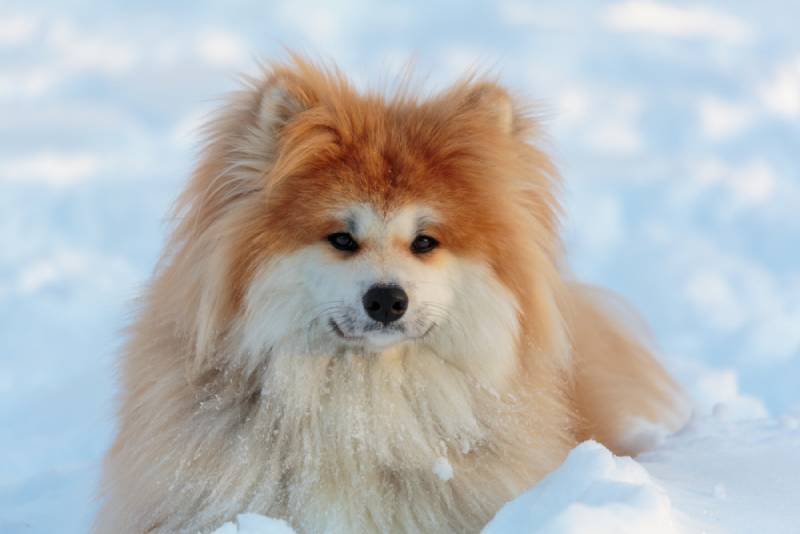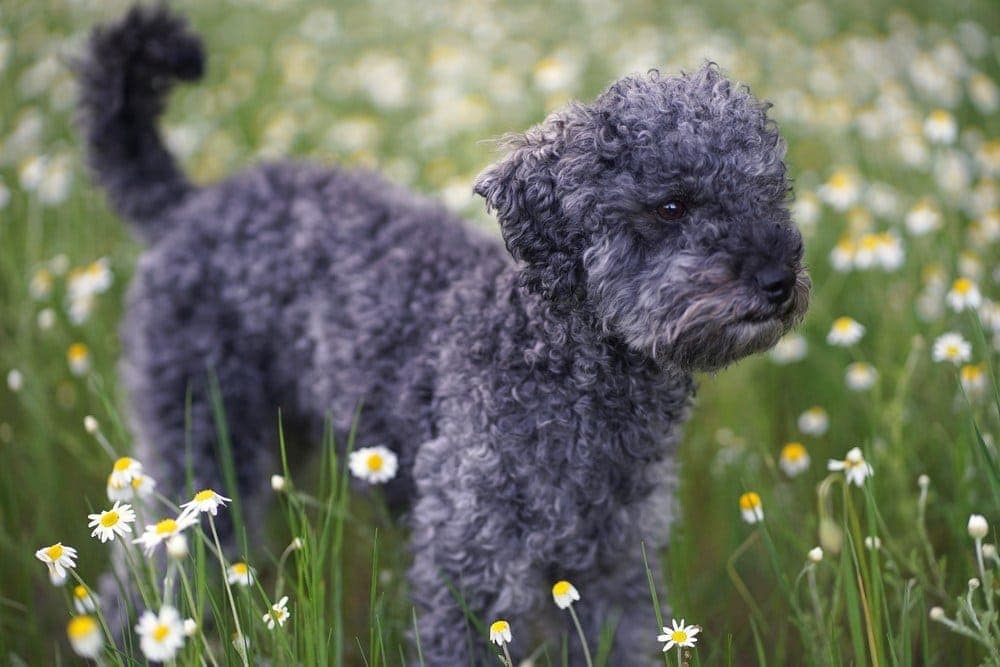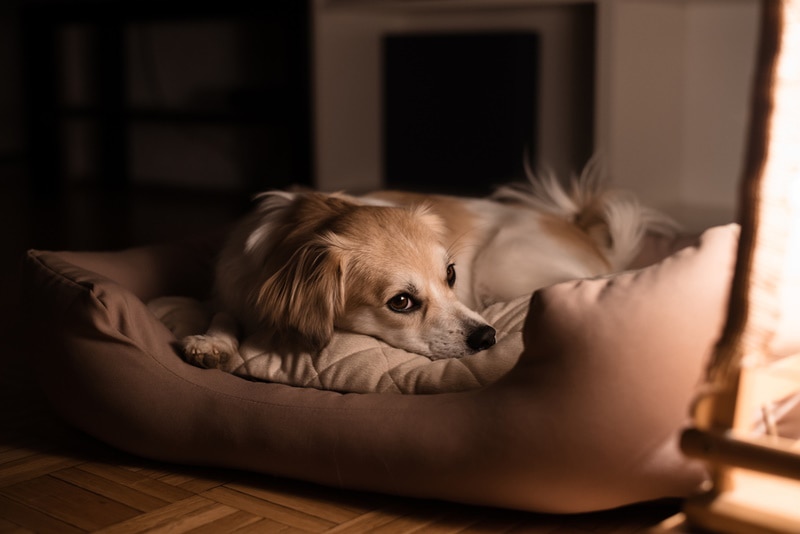Long Coat Akita Dog Breed: Facts, Origin & History (With Pictures)

Updated on

Click to Skip Ahead
Compared to the standard coat Akitas, the long coat Akitas are larger, fluffier, and arguably more impressive.
They have longer guard furs caused by a recessive gene that was widely considered a genetic fault by Japanese judges in show rings. Although rare, they are popular today because of their cute and cuddly appearance.
Long Coat Akita Overview
| Height: | 60–80 lbs |
| Weight: | 22–26 inches |
| Lifespan: | 10 to 15 years |
| Colors: | Russet-red, brindle including black, gray, and silver |
| Suitable for: | Families with children, single-person homes, couples |
| Temperament: | Kind, loving, eager to please |
Long coat Akitas, fondly called Woolies, share the same heritage as their standard Akita counterparts. However, they are recognized as a separate breed because they have a denser undercoat and longer, softer, and silkier guard furs.
Apart from that, they share an almost similar breed profile as standard coat Akitas, with only subtle differences in their build and temperament.
Are you interested in learning more about the long coat Akita? Dive in for in-depth details about its history, temperament, care needs, and more.
Long Coat Akita Breed Characteristics
The Earliest Records of the Long Coat Akita in History
The long coat Akita dogs are believed to have originated in the cold, snowy, and windy northern Japan Mountain regions.
Breeders crossbred the Akita and the Karafuto Ken, also known as the Sakhalin Husky, to create a dog with a warmer, more insulating coat.
The Karafuto Ken, a sled dog native to Russia, has a thick double undercoat. Breeding it with the Akita assured breeders of creating an energetic and hardworking hybrid whose dense coat could withstand the low temperatures prone to the Northern provinces of Japan.
At the time, dog shows were not a thing, and breeders merely wanted a guard dog that could also hunt and herd cattle.
The Akita acquired a recessive gene from the Karafuto Ken, making its outer coat longer. The dog is also stockier, a characteristic typically frowned upon in dog shows.
How the Long Coat Akita Gained Popularity
The Akita and Karafuto-Ken dogs are both popular breeds. Although the Karafuto-Ken is nearly extinct today, it enjoyed the spotlight in the late 1950s. Two dogs of the breed named Taro and Jiro became national heroes after surviving adverse weather in Antarctica for over a year.
According to the American Kennel Club, the standard coat Akita was the 47th most popular dog in the United States in 2018.
The long coat Akitas have been subject to discriminatory remarks for almost as long as they have existed. Most were historically culled or abandoned as puppies to maintain the Akita breed standard.
Fortunately, modern folk have a different perspective and don’t see them as “flawed” or “impure.” Akita dog enthusiasts stirred the breed’s popularity in the Western world around the 21st century. Soon after, even the Japanese began advocating for the formal recognition of the long coat Akita.
Formal Recognition of the Long Coat Akita
Unfortunately, they are yet to be formally recognized by the AKC and do not qualify for exhibition. There have been ongoing efforts to have the breed recognized and removed from the list of “impure” canines with flaws. Among the most notable is the Jayda McLaren petition to the Akita Club of America.
Top 3 Unique Facts About the Long Coat Akita
Long coat Akitas may result from a recessive gene anomaly, although their “imperfection” is today considered a cute factor. Unlike standard Akitas that look fox-like, long coat Akitas look like cuddly teddy bears.
Here are three unique facts about Woolies.
1. They Have a Great Temperament for Therapy Dogs
Long coat Akitas have lovely temperaments that make them ideal for pet therapy.
They are incredibly loyal and affectionate towards their family members. Although they can be aloof and wary of strangers, just like their standard coat counterparts, they warm up to new faces and environments if adequately trained and socialized.
Most breeders are quick to note that Woolies have a milder temperament. They are not as quick to aggression as their standard coat counterparts. Still, they make excellent guard dogs and can bite to protect the members of their pack.
As a working dog, the long coat Akitas are brilliant.
However, they are independent and stubborn, which can get in the way of successful training. You must establish yourself as the alpha and use positive reinforcement training methods to get the best outcome from your sessions.
2. Long Coat Akitas Are Somewhat a Rarity
Long coat Akitas are rare mainly because they are not widely accepted in their native country. In Japan, the standard coat Akitas are considered more valuable, and most breeders will not intentionally produce their long-coated counterparts.
Fortunately, Woolies have 100% the bloodline of the standard breed.
They merely have a different coat because of a recessive gene that can pop up in litters, especially if the parent breeds don’t undergo genetic testing before breeding.
3. Standard and Long Coat Puppies Look the Same
You cannot distinguish between standard coat and long coat Akita puppies. Both look like chubby furballs, and any differences in coat length do not appear until they are at least eight weeks old.
Reliable breeders do numerous genetic tests on the dogs they breed. As such, they know the likelihood of an Akita parent bearing a long-coated offspring.
Because of the rarity of such puppies, most breeders will hold onto the potential litters for at least ten weeks. This allows them to hike the price if they are lucky to get a long-coated puppy. The average cost of an eight to ten weeks old Woolie in the United States is between $2,000 and $4,500.
Does the Long Coat Akita Make a Good Pet?
Woolies make great furry companions! They are loving, affectionate and form close bonds with their family members. Moreover, they are not as quick to aggression as their short-coated counterparts.
Still, these dogs are best suited for individuals and families with grown children. Although they are mild-tempered, they have a short threshold for the usual annoyances imposed on dogs by small children.
They are also wary of strangers and fit best into families with the time, energy, and patience to provide proper training and socialization.
Your pet will require more than average grooming and plenty of daily exercises to burn pent-up energy. Still, these dogs are gentle companions when raised right. Their intelligence, boldness, loyalty, and protective demeanor make them exceptionally good guard dogs.
Final Thoughts
Long coat Akita dogs have a cuddly appearance because of their long, fluffy coats. They are pretty rare, and you should count yourself lucky if you own one or even manage to catch a glimpse of one.
Although Woolies don’t have a pretty history, they are today widely accepted as invaluable furry companions. They even make excellent therapy dogs because of their mild temperaments and affectionate personalities.
If you want to adopt this dog breed, make sure you are prepared to cater to the demands of a large and fluffy pet. Also, you must be prepared to provide intensive training and socialization to make it easier for your pet to lighten up to other pets, people, and places.
Featured Image Credit: GTole











